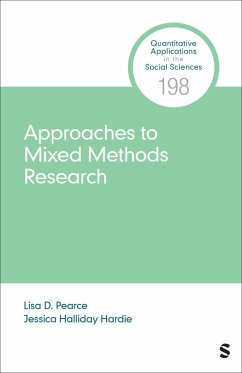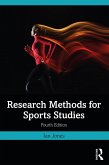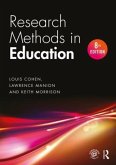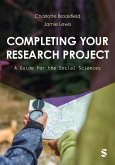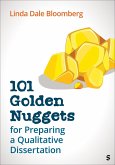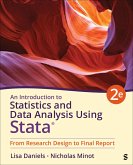- Broschiertes Buch
- Merkliste
- Auf die Merkliste
- Bewerten Bewerten
- Teilen
- Produkt teilen
- Produkterinnerung
- Produkterinnerung
Approaches to Mixed Methods Research shows how social scientists design studies that mix quantitative and qualitative data in ways that lead to a more holistic body of evidence from the research.
Andere Kunden interessierten sich auch für
![Research Methods for Sports Studies Research Methods for Sports Studies]() Ian Jones (UK Bournemouth University)Research Methods for Sports Studies88,99 €
Ian Jones (UK Bournemouth University)Research Methods for Sports Studies88,99 €![Research Methods in Education Research Methods in Education]() Louis Cohen (UK Loughborough University)Research Methods in Education147,99 €
Louis Cohen (UK Loughborough University)Research Methods in Education147,99 €![Completing Your Research Project Completing Your Research Project]() Charlotte BrookfieldCompleting Your Research Project28,99 €
Charlotte BrookfieldCompleting Your Research Project28,99 €![101 Golden Nuggets for Preparing a Qualitative Dissertation 101 Golden Nuggets for Preparing a Qualitative Dissertation]() Linda Dale Bloomberg101 Golden Nuggets for Preparing a Qualitative Dissertation39,99 €
Linda Dale Bloomberg101 Golden Nuggets for Preparing a Qualitative Dissertation39,99 €![An Introduction to Statistics and Data Analysis Using Stata® An Introduction to Statistics and Data Analysis Using Stata®]() Lisa DanielsAn Introduction to Statistics and Data Analysis Using Stata®101,99 €
Lisa DanielsAn Introduction to Statistics and Data Analysis Using Stata®101,99 €![Doing Research in the Real World Doing Research in the Real World]() David E. GrayDoing Research in the Real World43,99 €
David E. GrayDoing Research in the Real World43,99 €![Doing a Literature Review Doing a Literature Review]() Chris HartDoing a Literature Review31,99 €
Chris HartDoing a Literature Review31,99 €-
-
-
Approaches to Mixed Methods Research shows how social scientists design studies that mix quantitative and qualitative data in ways that lead to a more holistic body of evidence from the research.
Produktdetails
- Produktdetails
- Quantitative Applications in the Social Sciences
- Verlag: SAGE Publications Inc
- Seitenzahl: 136
- Erscheinungstermin: 8. April 2025
- Englisch
- Abmessung: 212mm x 142mm x 12mm
- Gewicht: 186g
- ISBN-13: 9781544339788
- ISBN-10: 154433978X
- Artikelnr.: 72487328
- Herstellerkennzeichnung
- Libri GmbH
- Europaallee 1
- 36244 Bad Hersfeld
- gpsr@libri.de
- Quantitative Applications in the Social Sciences
- Verlag: SAGE Publications Inc
- Seitenzahl: 136
- Erscheinungstermin: 8. April 2025
- Englisch
- Abmessung: 212mm x 142mm x 12mm
- Gewicht: 186g
- ISBN-13: 9781544339788
- ISBN-10: 154433978X
- Artikelnr.: 72487328
- Herstellerkennzeichnung
- Libri GmbH
- Europaallee 1
- 36244 Bad Hersfeld
- gpsr@libri.de
Lisa D. Pearce is Professor and Chair of the Department of Sociology at the University of North Carolina at Chapel Hill. She is also a Faculty Fellow at the Carolina Population Center. Her research examines how religions and families shape ideas and behavior from youth into adulthood-in the U.S. and Nepal. Pearce has published three previous books, and her articles have appeared in outlets such as Social Forces, Journal for the Scientific Study of Religion, and Journal of Marriage and Family. Pearce's research often integrates the collection and analysis of qualitative and quantitative data, and she writes and teaches about mixed methods research.
Series Editor Introduction
Acknowledgments
About the Authors
Chapter 1: What Is Mixed Methods Research and Why Use It?
The Field of Mixed Methods Research
Clarifying Some Terminology
Overview of the Book
Chapter 2: Developing Research Questions and Hypotheses in Mixed Methods
Research
Predetermined Research Questions or Hypotheses for Mixed Methods Research
Emergent Research Questions or Hypotheses in Mixed Methods Research
Application Exercises
Chapter 3: Sampling and Case Selection
Sampling in Concurrently Designed and Collected Mixed Methods Projects
Sequential Sampling in Mixed Methods Projects
Application Exercises
Chapter 4: Combining Methods to Improve Data Collection Tools
Improving Quantitative Data Collections With Findings From Qualitative Data
Results From Quantitative Data Informing the Collection of Qualitative Data
Hybrid Data Collection Tools
Application Exercises
Chapter 5: Integrating Quantitative and Qualitative Data in Analysis and
Interpretation
Rationale for Mixing Data Analyses
The Process of Integrating Different Data Analyses
Application Exercises
Chapter 6: Challenges and Rewards in Mixed Methods Research
Common Issues in Mixed Methods Research
When to Use a Mixed Methods Approach (or Not)
Rewards of a Mixed Methods Approach
What the Future Holds
Application Exercises
Appendix: Mixed Method Studies by Chapter
References
Acknowledgments
About the Authors
Chapter 1: What Is Mixed Methods Research and Why Use It?
The Field of Mixed Methods Research
Clarifying Some Terminology
Overview of the Book
Chapter 2: Developing Research Questions and Hypotheses in Mixed Methods
Research
Predetermined Research Questions or Hypotheses for Mixed Methods Research
Emergent Research Questions or Hypotheses in Mixed Methods Research
Application Exercises
Chapter 3: Sampling and Case Selection
Sampling in Concurrently Designed and Collected Mixed Methods Projects
Sequential Sampling in Mixed Methods Projects
Application Exercises
Chapter 4: Combining Methods to Improve Data Collection Tools
Improving Quantitative Data Collections With Findings From Qualitative Data
Results From Quantitative Data Informing the Collection of Qualitative Data
Hybrid Data Collection Tools
Application Exercises
Chapter 5: Integrating Quantitative and Qualitative Data in Analysis and
Interpretation
Rationale for Mixing Data Analyses
The Process of Integrating Different Data Analyses
Application Exercises
Chapter 6: Challenges and Rewards in Mixed Methods Research
Common Issues in Mixed Methods Research
When to Use a Mixed Methods Approach (or Not)
Rewards of a Mixed Methods Approach
What the Future Holds
Application Exercises
Appendix: Mixed Method Studies by Chapter
References
Series Editor Introduction
Acknowledgments
About the Authors
Chapter 1: What Is Mixed Methods Research and Why Use It?
The Field of Mixed Methods Research
Clarifying Some Terminology
Overview of the Book
Chapter 2: Developing Research Questions and Hypotheses in Mixed Methods
Research
Predetermined Research Questions or Hypotheses for Mixed Methods Research
Emergent Research Questions or Hypotheses in Mixed Methods Research
Application Exercises
Chapter 3: Sampling and Case Selection
Sampling in Concurrently Designed and Collected Mixed Methods Projects
Sequential Sampling in Mixed Methods Projects
Application Exercises
Chapter 4: Combining Methods to Improve Data Collection Tools
Improving Quantitative Data Collections With Findings From Qualitative Data
Results From Quantitative Data Informing the Collection of Qualitative Data
Hybrid Data Collection Tools
Application Exercises
Chapter 5: Integrating Quantitative and Qualitative Data in Analysis and
Interpretation
Rationale for Mixing Data Analyses
The Process of Integrating Different Data Analyses
Application Exercises
Chapter 6: Challenges and Rewards in Mixed Methods Research
Common Issues in Mixed Methods Research
When to Use a Mixed Methods Approach (or Not)
Rewards of a Mixed Methods Approach
What the Future Holds
Application Exercises
Appendix: Mixed Method Studies by Chapter
References
Acknowledgments
About the Authors
Chapter 1: What Is Mixed Methods Research and Why Use It?
The Field of Mixed Methods Research
Clarifying Some Terminology
Overview of the Book
Chapter 2: Developing Research Questions and Hypotheses in Mixed Methods
Research
Predetermined Research Questions or Hypotheses for Mixed Methods Research
Emergent Research Questions or Hypotheses in Mixed Methods Research
Application Exercises
Chapter 3: Sampling and Case Selection
Sampling in Concurrently Designed and Collected Mixed Methods Projects
Sequential Sampling in Mixed Methods Projects
Application Exercises
Chapter 4: Combining Methods to Improve Data Collection Tools
Improving Quantitative Data Collections With Findings From Qualitative Data
Results From Quantitative Data Informing the Collection of Qualitative Data
Hybrid Data Collection Tools
Application Exercises
Chapter 5: Integrating Quantitative and Qualitative Data in Analysis and
Interpretation
Rationale for Mixing Data Analyses
The Process of Integrating Different Data Analyses
Application Exercises
Chapter 6: Challenges and Rewards in Mixed Methods Research
Common Issues in Mixed Methods Research
When to Use a Mixed Methods Approach (or Not)
Rewards of a Mixed Methods Approach
What the Future Holds
Application Exercises
Appendix: Mixed Method Studies by Chapter
References

